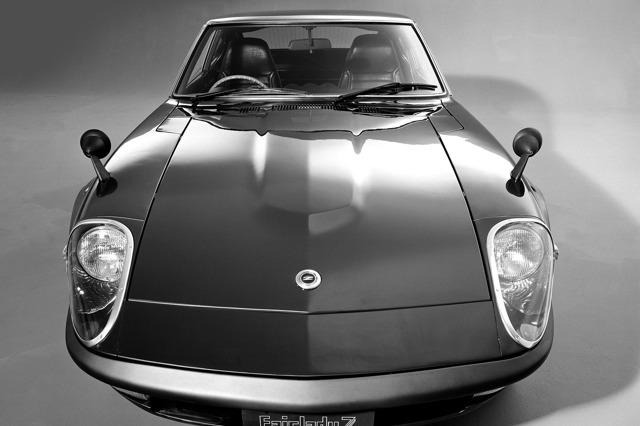Nissan Datsun 240Z (1969 – 1975) Review
Nissan Datsun 240Z (1969 – 1975) At A Glance



The Datsun 240Z wasn't Japan's first sports car. It wasn't even Nissan's, as that honour goes to the open-topped Fairlady. But it was the first sports car from the Pacific Rim that achieved huge international success, especially in the USA. And Nissan's formula for sales success with this car was simple: was to imitate the British sports car such as the MGC and Triumph GT6, by accentuating their good points and eliminating the legions of faults.
The 240Z's looks were spot on, thanks to styling influenced by a Count Albrecht Goertz concept developed for Datsun in the early 1960s. Performance from its rorty 2.4-litre power unit that owed a lot to the BMC C-Series and well as Mercedes-Benz's straight-six, was more than ample. Being a Datsun, reliability was a given, but the agile (if tail-happy) handling was a pleasant surprise. During its five year run, more than 150,000 were produced, but survivors are now seriously appreciating. Rust has been its main enemy, so be careful when buying, even if you're buying a restored example.
Model History
- January 1964: Nissan and Yamaha join forces to develop the A550X prototype
- October 1965: Yoshihiko Matsuo chosen to lead the development of Nissan's own sports car
- January 1967: Project Z gains traction
- November 1967: Project Z approved for production
- November 1968: Running prototypes begins testing
- October 1969: Datsun 240Z goes on sale
- January 1971: Minor running changes made to the 240Z
- September 1973: The 240Z is replaced by the 260Z
January 1964
Nissan and Yamaha join forces to develop the A550X prototype
One of Nissan's senior executives, Yutaka Katayama, had been working in the USA since March 1960, helping setting up (NMC USA), the company's North American import and sales division. He oversaw Nissan's early expansion and growth, and his career blossomed just as quickly. By 1965, he was the president of NMC USA. Katayama and colleague Keiichi Matsumura began lobbying Japanese management to build a sports car tailored specifically to the US market.
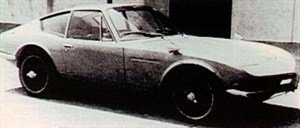
The result was the A550X (right) project, a 2.0-litre coupe, developed in association with Yamaha. For the styling, Nissan wanted a European designer, and commissioned Albrecht Goertz to pen some proposals. Goertz was an interesting character, an Austrian aristocrat, who styled the wonderful BMW 507, and one with a taste for self-promotion.
The A550X joint venture project was developed into a full-scale running prototype, and was powered by Yamaha's jewel-like straight-six, but failed to gain traction, and eventually was cancelled by Nissan in June 1964. As a side note, Yamaha perservered with the project and ended up taking it to Toyota - with the production version emerging in 1967 as the delightful 2000GT. History will record that car as a wonderful machine, but also backs up Nissan's decision not to build the car - as a mere 337 were built.
October 1965
Yoshihiko Matsuo chosen to lead the development of Nissan's own sports car
The continued development of a new Nissan sports coupe was as the result of a battle between the US dealers and Japanese management. The former wanted the car; the latter did not.
Teiichi Hara, head of Nissan's Engineering Design and Development department, appointed sports car-loving Yoshihiko Matsuo as head of the new Sports Car Design Studio. His first assignment was to devise the new coupe that the US dealers so dearly wanted. Matsuo perservered with his US-inspired sports car designs, despite a lack of support from Nissan's management, which had concluded that sports cars were not really a priority for the company. The Silvia coupe and Fairlady roadster were a long way from being successful, and that did little to convince management to stop being so conservative.
Katayama worked hard to convince management to perservere with the project, and was buouyed-up by Matsuo's enthusiasm for the new project.
January 1967
Project Z gains traction
Matsuo had progressed the designs to clay model stage by this point - and the good looking cars were gaining an increasing number of allies within the company. A pivotal moment in the development of Project Z was engineer Hisashi Uemura, head of Nissan's Section Three production division, climbed aboard and had his section lend some staff to assist with the programme.
There were several design proposals, but the final design chosen was a conventional coupe, which took elements of the A550X, the Jaguar E-type, Triumph GT6 and Ferrari 275GTB/4 - but with an identity all of its own. Matsuo had undoubtedly created a stylish coupe, which continued to win friends within Nissan.
November 1967
Project Z approved for production
Rather like BMC's sports cars, Project Z was designed to use as many off-the-shelf components. Its suspension, and brakes were all used in the Cedric, and its 2.0- and 2.3-litre straight-six was a development of the Bluebird's 1.6-litre four-cylinder.
November 1968
Running prototypes begins testing
Road testing on Project Z took place in various locations, with the emphasis on the USA. Several technical changes were made as a result of this, included suspension changes, the fitment of a smaller fuel tank and an extensive weight reduction programme.
October 1969
Datsun 240Z goes on sale
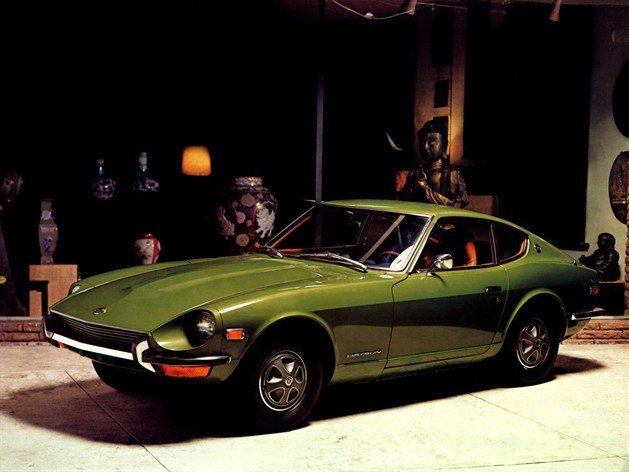
US specification Datsun 240Z
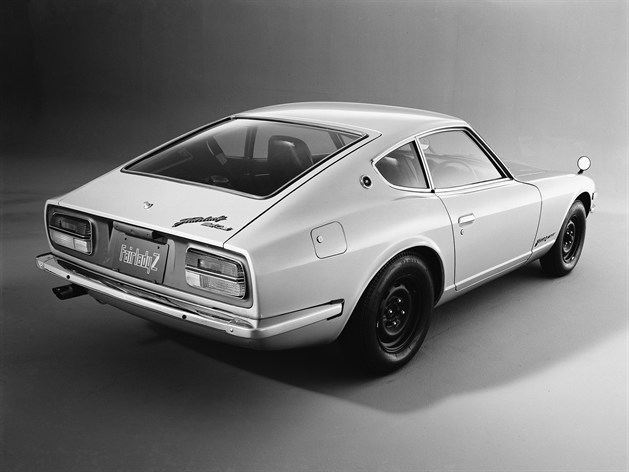
Japanese specification Nissan Fairlady Z
Project Z went into production on in the summer of 1969, and went on sale on 22 October. It was known as the S30 internally, was called Fairlady Z in its home market, but was renamed 240Z for the US and Europe - for obvious reasons.
The 240Z's technical specification was far more appealing than its mainly British opposition, the Triumph GT6 and MGB/MGC. It bosted fully independent suspension, with struts front and rear. Disc brakes were fitted up-front only, but were more than capable of reining in speed. Fat tyres were mounted on steel 14-inch wheels that had stylised hubcaps that had most buyers plumping for optional alloy wheels.
It was practical for two people, too, with a lift-up hatchback and capacious boot. There was plenty of showroom appeal, thanks to a low-slung driving position, deep recessed dials, and a 160mph speedo alongside a 8000rpm rev counter. The 240Z's was powered by a 2393cc engine (in export markets - the 2.0-litre was reserved for Japan), which developed 151bhp (SAE). In its January 1970 road test, Road & Track's January 1970 recorded a maximum speed of 122mph - but most owners will tell you their 240Z is a 125mph car.
The was an instant and substantial success in its intended market. The Americans took it to their collective hearts and 240Z was soon commanding a premium for potential owners who didn't want to join the waiting list. In the USA, Nissan had planned for 1600 cars per month, but the shipping quota of 2500 Zs per month was reached by mid-1971. The company could have sold many more.
January 1971
Minor running changes made to the 240Z
There were a few changes to the 240Z for 1971 - the air vents moved vents from the hatch to the C-pillars, and engine refinement was improved. The three-speed automatic version was introduced, but few buyers took up the option. Even by this time, two years into the production run, dealers were charging a premium for 240Zs.
September 1973
The 240Z is replaced by the 260Z
Production ends with 168,584 240Z built.
Driving Nissan Datsun 240Z (1969 – 1975)
The Datsun 240Z changed the face of the sports car market, and established its maker as front-running motor manufacturer that had more buyers than cars. With its deep-chested straight-six, lively handling, and keen pricing, everyone wanted one.
And more than 40 years later, the 240Z still as an adoring fan base. But does it live up to the legend?
Classic road test: Datsun 240Z
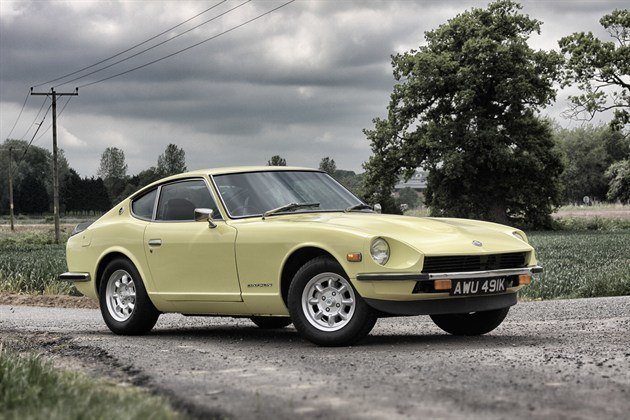
The sports car establishment in 1969 was beginning to look a little haggard, The MGB had been around for seven years, and the new straight-six powered MGC, which was so heavily based on it, was not quite the revolution enthusiasts had been hoping for. As for the Triumph GT6, also new in 1969, it was a direct evolution of the Spitfire - and that had been around since 1962. These were the cars to beat in 1969 - and were Datsun's prime targets for the 240Z.
They were fun to drive, but were saddled with mediocre performance and roadholding - especially in de-smogged US market form. Before the Datsun 240Z, this might have been forgiveable but, once the six-pot Datsun rocked up with its 151bhp and Austin Healey soundtrack, the market changed, and the British sports car manufacturers struggled to come up with a convincing reply.
The styling, near-perfectly resolved by Yoshihiko Matsuo, is as appealing today as it was when it went on sale, and American buyers were happy to pay their local Datsun dealer a premium, or join a lengthy queue, to own one. Before the 240Z, Japanese cars combined a degree of Detroit-inspired chintz with barely disguised Euro plagiarism – and rarely did they look at ease with themselves. The 240Z was none of these and, although its proportions hinted at Jaguar E-type or Triumph GT6, it was also great-looking.
Inside the 240Z
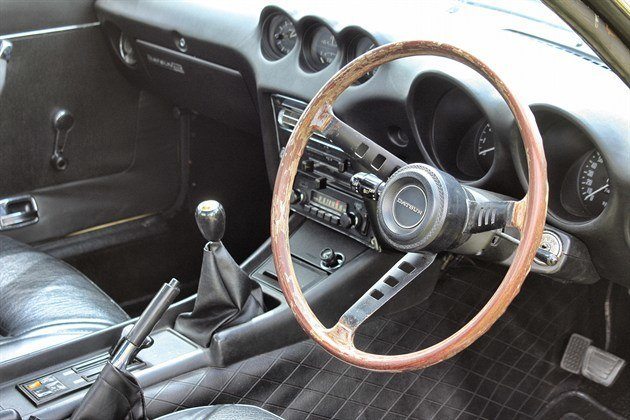
Inside, it’s all sports car, too. The reclined driving position, which sits you almost atop the rear axle, and upright wheel are standard fare, but the dashboard is a world apart from the traditional British sports car. The Z’s one-piece dash is beautifully sculpted and the bank of instruments set deeply within it is perfectly set out. The wide use of grained plastic was a world away from the wood or crackle-black slabs that passed for dashboards in British sports cars - it was a tangible move towards modernity.
The instrument layout is traditionally conventional, with the speedometer and rev counter getting due prominence directly ahead of the driver in their own deeply recessed nascelles. They contain their own dainty warning lamps, leaving room for the additional instruments to sit centrally atop the dashboard.
On the road
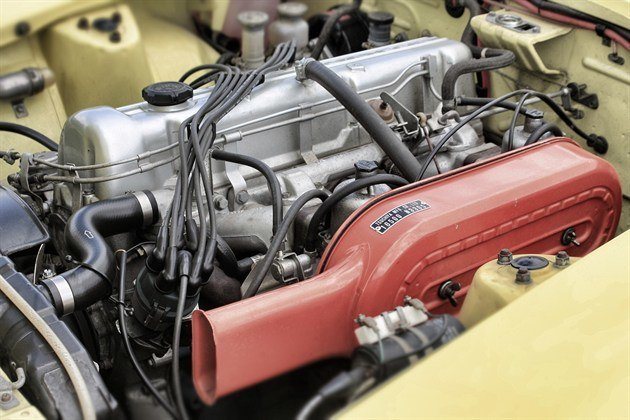
Firing it up doesn’t disappoint; the straight-six doesn’t take much stoking as long as you give it plenty of choke from cold. It settles down to a rock-steady and sweetly resonant idle. Heading off, it's smooth and quiet at low revs and when trickling - and in fact, it doesn't sound that sporting at all. The controls are heavy, the steering is direct, and offers plenty of feedback - and kickback - through its slim, wooden rim.
The gearchange is also weighty, and you have to be deliberate when selecting your ratio. The throttle is long and linear, and offers great adjustablility. This is clearly a car for the open road. Overall, the 240Z is easy to drive along with the flow. When you drive around town, the long bonnet is a disadvantage when you’re nosing out of side-roads.
Once you get out on to the open road, the 240Z's character changes. Clear of the urban sprawl, and as the speeds rise, the responsiveness of the steering improves and it starts to feel much lighter on its feet.
Once you get out on to the open road, the 240Z's character changes. Clear of the urban sprawl, and as the speeds rise, the responsiveness of the steering improves and it starts to feel much lighter on its feet. We adopt the slow-in, fast-out approach to corners, planting the throttle only once we're near the corner exit. The rear squats down, and as the outer rear wheel digs in, you feel everything the rear suspension's doing through both your palms and the base of the seat. That's no bad thing, as the rear will swing wide if you're caught out by a tightening radius or surface dampness.
And surface imprerfections reveal another dynamic issue - the suspension's lack of damping control. It's not a particularly firm set-up, but there are too many times when the sloppy damping has the 240Z crashing into its bump stops. We suspect a more modern set of shock absorbers and some new bushes would tie-down the rear end and accentuate this car's positive dynamic points.
The best way to push a 240Z along is to steer smoothly and feed it into the bends. There is some body roll to contend with, but the transition into lean is well controlled. That initial turn-in bite translates into a touch of entry understeer, but it is neutral enough not to frustrate keener drivers.
Performance
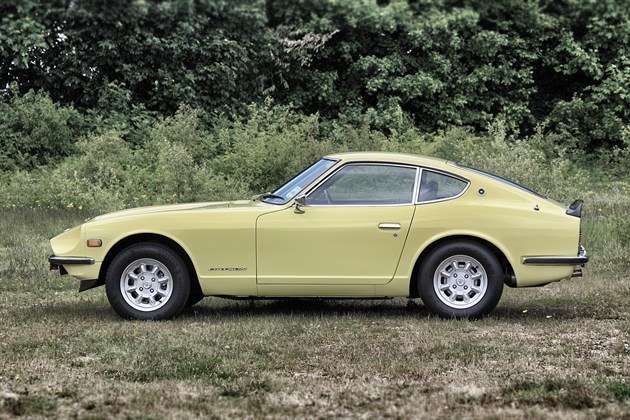
Straight line performance certainly isn't lacking. Planting the throttle in third at 50mph is a satisfying experience. The 2.4-litre straight-six was designed primarily for the Cedric but, rather like the Austin-Healey 3000 or MGC, what should be an unexciting engine delivers a soundtrack that eggs-on the driver. The deep-chested, mid-bass roar from 3000rpm is matched by purposeful acceleration.
According to Autocar in its 1971 road test, it was quick beyond the legal limit, too: 'In fifth gear we reached a mean maximum of 125mph just over the power peak at 5750rpm. The standing-start acceleration times were good. The clutch was let in smartly at 4000rpm and the car leapt off the line, leaving a few yards of rubber on the road. From here on, progress was rapid, indeed: 60mph was reached in 8.0sec exactly while still in second gear.'
The HJClassics Verdict
The 240Z was great to drive, looked good, and pleasantly quick. But that wasn't all that was in its armoury - it was reliable, dependable, and well serviced by efficient and helpful dealers.
The Datsun 240Z earned its stripes as a sports car - perhaps on looks alone. Its success back in the '70s was well-deserved, even if the company's management didn't expect it at all. A lot has been written about the 240Z's huge commercial success, and how it kick-started a long-line of sports cars that continues to this day, but most of the superlatives are warranted. It might feel old school today on challenging roads, but when it was new, the 240Z was a revelation compared with its ageing British rivals. And in its own way, helped hasten the demise of the affordable British sports car.
The 240Z is great to drive, looks good, and is pleasantly quick. But back in 1969 that wasn't all that was in its armoury - it was reliable, dependable, and well serviced by efficient and helpful dealers. Culture shock for MG and Triumph owners. And that underlines another home truth – the Japanese mastered reliability in affordable cars long before everyone else. The Datsun 240Z was – and is – the perfect sports car for everyone. We'd say bag a bargain while you can, but rising values already reflect their desirability.
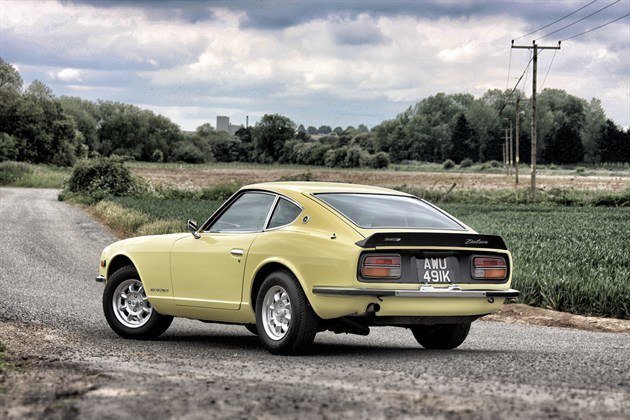
Nissan Datsun 240Z (1969 – 1975) Buying Guide
Bodywork
The biggest 240Z killer is corrosion, as was the case with seemingly all Japanese car of this era. There are specific areas to check more closely than others, but most areas of the monocque and bolt-on panels are vulnerable.
- The main concern should be with the structural elements of the monocoque. Exterior panels such as the bonnet, front wings and doors can be replaced fairly easily. The chassis rails, inner wings and floor pans, as well as the real quarter panels are very expensive to replace properly.
- Many first generation Z Cars have been patched rather than correctly repaired.
- The engine and front suspension depend on the strength of the front chassis legs and the integrity of their connection to the inner-wing wells and floorpan. So closely check these areas.
- When under the bonnet, inspect the chassis legs on both sides of the car.
- Look for rust where they meet the monocoque.
- Also check under the battery on the inner wing and on down to the chassis rails.
- Over time, battery acid eats through the paint, and then it rusts completely though.
- Check for rust in and around the bumpers. Look behind them, they rust from behind through the chrome layer - so a very small hole in the chrome may mean an expensive bumper is scrap.
- Look underneath at the floorpan. Watch for bad or poorly done repairs, which have been covered up with thick underseal. The factory undercoat was finished in body coloured paint, so if this isn't so, look closely.
Electrical system and other sundries
- Do all the lights and controls work? Does the windscreen wiper motor work? Gauges?
- Doors. Do the doors open/close smoothly? Do the windows roll up/down freely?
- Locks. Do all the locks work correctly?
- Cables/mechanisms. Do the choke, bonnet, parking brake cables/levers all work smoothly?
Is it complete?
Depending on your intended use of the car, you'll want your 240Z to be complete, or at leas comes with all the parts that you will need are there.
Engine and gearbox
- Check to see if the car still has its original engine - many have been changed along the way.
- The original engine serial number is stamped VIN plate under the bonnet, and on the block itself. Make sure they tally.
- Also check to see that all the original engine parts are still there.
- Check that the gears engage smoothly and that syncromesh works on all ratios - they're especially vulnerable in first and second gears.
- Watch out for engine smoke and evidence of oil burning.
Interior
- The interior trim is tough and long-lasting, being made almost exclusively from plastic and vinyl - but the seat trim and dash tops are susceptible to tearing and cracking, and can be awkward to repair.
- Make sure that the car has the original gauges in the dash, and that they all work.
- This will give you a clue as to if the entire dash has been replaced.
Nissan 240Z
| 0–60 | 8.3 s |
| Top speed | 125 mph |
| Power | 160 bhp |
| Torque | 198 lb ft |
| Weight | 1025 kg |
| Cylinders | I6 |
| Engine capacity | 2493 cc |
| Layout | FR |
| Transmission | 5M |

.jpg?width=640&height=426&rmode=crop)
.jpg?width=640&height=426&rmode=crop)
.JPG?width=640&height=426&rmode=crop)
.JPG?width=640&height=426&rmode=crop)
.JPG?width=640&height=426&rmode=crop)
.JPG?width=640&height=426&rmode=crop)
.JPG?width=640&height=426&rmode=crop)
.JPG?width=640&height=426&rmode=crop)
.jpg?width=640&height=426&rmode=crop)
.jpg?width=640&height=426&rmode=crop)
.jpg?width=640&height=426&rmode=crop)
.jpg?width=640&height=426&rmode=crop)
.jpg?width=640&height=426&rmode=crop)
